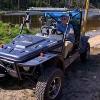Front Drive Line
-
Similar Topics
-
By didgeridoo
Hello, All! I've decided to replace the traction batteries in my 2018 Sector E1 with a 48V Lithium set. They may be expensive, but I figure the Discovery Dry Cell are, too. I am not looking for the max driving range, as I have never received near the brochured range to begin with, but a good mix of charge/ get work done/ charge is what I am expecting.
I have settled on the 48V EAGL kit from bigbattery dot com. Each battery pack provides 30Ah. The kit ships with a charger, as well. The packs would be physically connected in parallel (using a busbar) to one another, maintaining the 48V voltage, but together would be able to provide the amp draw the buggy pulls when going up hill or towing a rake (rated 320 max continuous Amps). This is in comparison to the serial connection the eight 6V lead batteries. Each of the EAGL batteries looks to have its own BMS; am I correct in thinking I will have to use their included charger rather than (simply) changing the onboard charger to lithium mode? The chemistry of the pack is LiFe PO4, for what it's worth. I haven't torn anything apart yet (to diagram), so I am not sure how the dash will interpret the AMP draw, but the kit I am looking at includes a dash mounted charge indicator.
If anyone has completed a similar conversion, do you have any tips? Specifically, how did you remove the original batteries, and how did you secure the new ones? I am guessing that almost any change from the stock batteries would involve at least some modifications. Any tips would be appreciated, especially things I may have failed to consider. Thanks!
-
By mcraigchr
Howdy y'all,
I have the service manual, but it leaves me with questions.
1) It is time to change the diff fluid. The service manual says 80w-90 for the rear and Dextron 3 ATF for the front! Is that correct? That seems odd to me.
2) The service manual also speaks of the need to change the transmission fluid but gives no detail about it. What needs to happen here?
3). The service manual also discusses changing the final drive fluid with 80-90 Hypoid. Is the final drive actually the tranny?
Any details about the changing of the fluid or what fluid to use ... or even other things that need to be changed that the manual does not mention would be appreciated.
Thanks,
Craig C.
-
By lincolnsq175
Ive searched and cannot find any performance parts that fit my machine.
I have a 2020 coleman ut400.
Im looking for machined sheave kit, programmers, cdi, exhaust and intake.
I know these are yamaha rhino clones but are they rhino 450 clones?
Any info is appreciated.
-
By CRV
Howdy new member here . My hobby's Rabbit dogs , gamefowl . I'm retired from my real job but I stay busy with the hounds and gamefowl . So to help around the farm I ran across an old 2007 CC Big Country 4x2 to haul feed , water , sprayer and my sorry a$$ .It is in pretty good shape , 781 hrs. good plastic , tires, ect. . But as anything outside and 18 years old it needs seats ! The thing I have found wrong mechically the Diff. Lock Acturtor is broken where it mounts to the bracket ( partly why Im here ) . Hoping someone here can help ! Just my wish list but Id like to find a roll cage and a composit/plastic top for it Im thinking I'll need a donor to salvage these things from ( again partly why Im here ) .Is there another brand that uses this same actuator? If anyone reads this and has or knows of any of threse parts PLEASE HOLLER !!
Again Howdy brothers & sisters
-
-
By Robbie Wyre
I'm working on a 2005 Cub Cadet side by side and I'm trying to remove the front two axles. I have a slide hammer puller on the inner joint and with all my strength they will not budge. Anyone have the same issues and is there something I'm missing or a trick of some sort to pull these out? Any suggestions please and thank you.
-







Recommended Posts
Join the conversation
You can post now and register later. If you have an account, sign in now to post with your account.
Note: Your post will require moderator approval before it will be visible.